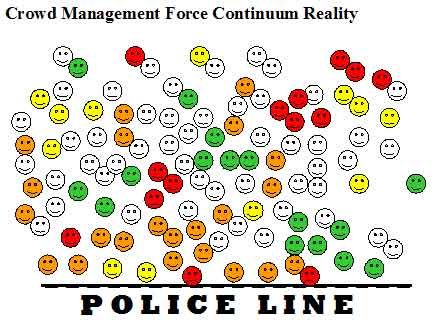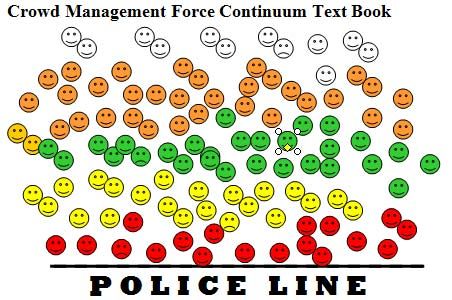When reviewing the Boston incident we want to focus on two important issues: one of being able to educate the media in the language used in explaining the specific incident, and the second, focus on training points.
If you review the Boston article you will see that the wording used to describe the weapon used was incorrect. For one there is no such weapon as a “Pepper Spray Gun.” The actual weapon used was the FN303, which is designed not to cause serious bodily harm when used. This FN303 weapon deploys a round-shaped sphere which travels at a high rate of speed (Much more then the original PepperBall Launcher originally designed by Jaycor for the military) and is supposed to break apart at impact causing a chemical irritation and measure of pain.
These are two different weapons. The “Pepperball Launcher,” deploys a lighter round which is designed to break at impact and may deliver a certain measure of pain, where the FN303 delivers a heavier round and it travels at a much faster velocity. Even though the FN303 round is designed to break at impact, its velocity pushes the round down range to the target faster.
I have been hit by both of these rounds at the distance of 20 feet, and both had different effects. The FN303 round hit with much more force, and out the three rounds fired only one broke at impact; the other two bounced off my calf. You could see the indention it made on the lower part of my jeans. It never penetrated the jeans but did in fact separate the fabric.
The “Pepperball,” Launcher was deployed, the three rounds all broke at impact and delivered a certain amount of pain with no tearing or server damage to the lower part of the jeans.
Both left small dime- to quarter-size markings on my calf, called a hematoma, from the internal bleeding that was caused from the impact. Both minor blunt trauma marks, the FN303 rounds lasted about 12 days and the others about nine days.
The second misinformation was the “switching to a weapon that fires pellets at a lower velocity. The term pellets are used to describe small round in shape rubber balls measured at either 31. , 32. or .60 caliber. These are referred to stinger balls. These have no chemical deployment and their sole function is to deliver a measure of pain to deter the subject.
Our second focus is the training. Like any use of force tool an agency uses, training is paramount. Training in the basic nomenclature of the weapon, handling, and the operational aspects of it, how it will function and its design should be covered. In this industry we have two separate directions when it comes to training. One direction of training is from the manufacture on the technical design and specific information pertaining directly to their product and then the tactical deployment of the product.
Unfortunately it is very rare you receive both at the same time. The word training for departments usually begs the question, “How much is this going to cost us in equipment, man power and compensation of personnel.” Manufactures translate training into liability of what are they truly obligated under law to cover, and the user translates training as their own survival in, and out, of the courtroom.
There are always a series of procedures an officer goes through when selecting and deploying a weapon during any physical encounter. We follow our department model of the force continuum, and then look at the threat to define the perception of risk to both officer and subject, and then add it to the reality of our threat at hand.
Here is a basic chart we use in our training to help make more accurate decisions when using non lethal weapons.
 ZONE # 5 150-200 FT. FROM THE LINE
ZONE # 5 150-200 FT. FROM THE LINE
ZONE # 4 100-150 FT. FROM LINE
 ZONE # 3 50-100 FT. FROM LINE
ZONE # 3 50-100 FT. FROM LINE
ZONE #2 10-50 FT. FROM LINE
 ZONE #1 0-10 Feet. FROM LINE
ZONE #1 0-10 Feet. FROM LINE
Above is used as a general reference to understand the impact of less-lethal weapons and the use-of-force options available to officers, in conjunction with the relationship between various weapons delivery systems and their effectiveness. At certain distances they deliver a physiological and psychological deterrent; at other distances only a psychological deterrent.
 |
 |
l


